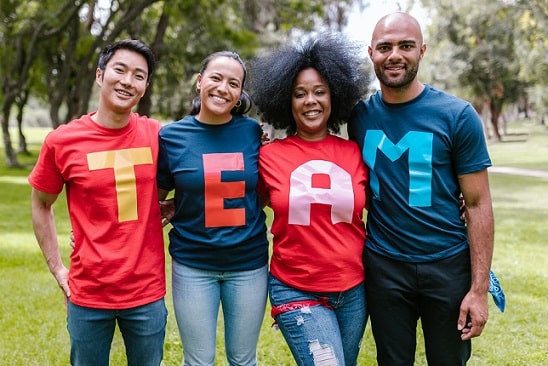Benefits of Diversity and Inclusion in the Workplace | Statistics
Diversity and inclusion (or as it is often abbreviated D&I) is part of the shift in a business perspective and human focus that is becoming stronger and stronger in all industries.
It is becoming more and more common for companies to consult on this topic or even have a dedicated person to ensure good D&I practices in the company.
And these companies are right. D&I is not a topic to be taken lightly, as it is necessary to ensure the full integration of diverse groups at different levels of the company and in decision-making.
And this is not an easy task, the diversity of a group includes multiple characteristics such as age, sex, gender, race, religion, nationality, etc., and achieving the participation of these groups in all areas of a company can be a full-time job.
For example: it is not enough to include a quota for women’s representation in the general payroll if at the administrative levels there is no representation or their ideas are not heard. It is important that at all levels there is a such representation and that their voices are equally heard to achieve inclusiveness. Only in this way will the benefits of D&I be realized in the company.
To give a push to the consideration of D&I in companies, today we are going look at statistics and talk about the most important benefits obtained by workplaces that decide to integrate diversity and inclusion in their workplaces.
Does your company provide equal employment opportunities to all employees and applicants? Start publishing your vacant jobs for people with disabilities on our platform. What are you waiting for to hire people with disabilities?
1. A wider talent pool for recruitment
One great benefit of diversity and inclusion in the workplace is ensuring bright candidates won’t get turned down by virtue of their gender, skin color, or other attributes, despite having great skills and experience.
This means a higher number of high-quality candidates a company can choose from when hiring. For instance, a company that does not encourage women to join them is missing out on the talents and abilities of half the population. The same can be extended to other minority groups.
Source: The Ew Group.
2. Teamwork and better problem solving

Having diversity and inclusion in teams can help improve team processes and boost group collaboration.
- Regarding gender diversity, researchers have observed that women have better skills in reading non-verbal cues.
- And groups with more women are better at taking turns in conversation, which helps them make the most of the group’s combined knowledge and skills.
- Also, when deciding which ideas to test and putting more resources behind, diverse and inclusive teams are faster and far better than homogenous ones.
Statistics collected by Cloverpop on its decision management platform found that the more diverse the team (by gender, geography, and age) the better the decision they made:
- Teams made decisions 60% faster than non-diverse teams, and made the right decision 87% of the time, compared to 58% for all-male teams.
Source: The Ew Group.
3. Employee retention

Having an inclusive culture in your workplace boosts morale and opportunity. Inclusive workplaces tend to have lower employee churn rates, representing big savings in terms of time and money spent on recruitment.
The reason behind this is that when employees don’t feel that their ideas, presence, or contributions are truly valued or taken seriously by their organization, they will eventually leave.
A Great Place to Work research found that employees who trust that they, and their colleagues, will be treated fairly regardless of race, gender, sexual orientation, or age, are:
- 9.8 times more likely to look forward to going to work
- 6.3 times more likely to have pride in their work
- 5.4 times more likely to want to stay a long time at their company
Source: Great Place to Work: D&I
4. Understand the customer better
Our society is incredibly diverse and most of these people are active in the economy.
However, a lack of workplace diversity and inclusion can lead to large groups of customers not being represented, therefore, not being understood, and companies not taking advantage of their spending power. Let’s see some statistics.
- In the UK, 13.9 million people are disabled, and their spending power is worth £249 billion.
- In the United States, this group represents $1 trillion in annual aggregate consumer spending.
If companies understand disabled demographics by hiring disabled employees they can focus many of their business efforts on tackling their needs. More importantly, this investment in hiring disabled individuals is beneficial on moral and ethical grounds, since it makes society work better for more people.
- LinkedIn’s 2018 Global Recruiting Trends found that 49% of companies focusing on diversity are doing it to improve customer representation.
Source: The Ew Group, UN.
5. Greater profitability
Research from Great Place to Work-Certified™ showed that the 100 companies with the largest gaps between the experiences of white employees and minorities had significantly lower revenue growth than the 100 companies with the smallest disparity.
The companies with the most significant gaps in diversity averaged 8.6% revenue growth, while more diverse companies averaged 11% growth.

- When employees in a high-trust culture experience a caring workplace, they are 44% more likely to work for a company with above-average revenue growth.
- Additionally, in 2012, a McKinsey study found that US companies with diverse executive boards had a 95% higher return on equity than those lacking diversity.
- In 2015, McKinsey found that the best-performing companies for gender diversity in management were 15% more likely to financially outperform the mean, and 35% more likely when it came to ethnic and racial managerial diversity.
- The HR Research Institute’s 2019 survey found that 61% of respondents agree that diversity led to improved performance.
Source: Great Place to Work: Diversity, The Ew Group.
6. Improve business innovation
A multiplicity of perspectives can spark creativity and innovation, and help organizations spot and seize new opportunities.
The more diverse these teams are along many dimensions (culture, ethnicity, gender, sexuality, age, experience level, educational background, expertise, etc.) the more likely they are to draw inspiration from seemingly unrelated places. These idea combinations lead to more unlikely—and more innovative—ideas.
Diverse teams have far more pathways to execute an idea, which enables them to iterate on them faster and more cost-effectively.
The surface area of the resources they can tap dramatically expands. Not only that, but they can also navigate the enterprise on a tight budget, and tap into networks they may not have otherwise explored on their own.
Businesses that boast diverse workforces are finding their capacity for innovation is being boosted.
- A 2019 survey by the HR Research Institute found that 66% of organizations believe diversity enhances innovation.
- 83% of employees surveyed for a 2013 Deloitte report felt their ability to innovate increased when they believed they were listened to and thought their organization was committed to and supportive of diversity.
- BCG’s 2017 Diversity and Innovation Survey found companies with above-average diversity scores reported higher innovation revenues (revenues from products released in the previous three years).
Source: Great Place to Work: Innovation, The Ew Group.
7. Reputation
Statistics show that having an inclusive workplace is a powerful recruiting tool. A reputation as an inclusive employer will also demonstrate your positive company values and that will enhance your reputation in the recruitment marketplace.
Having a reputation for being more diverse also means your company won’t be turned down by discerning candidates that are concerned about diversity and inclusion.
- A 2017 PwC survey of employees found that 45% of men and 54% of women researched prospective employers to see if they had diversity and inclusion policies, while 48% of men and 61% of women judged company leadership team diversity upon receiving a job offer.
- This number was higher in a 2018 Randstad study, which found that 78% of employees valued equal workplaces, and these percentages are likely to grow as younger demographics enter the workforce: a 2015 PwC survey found that 86% of millennial women considered workplace diversity and inclusion policies important.
Source: Workplace by Meta, The Ew Group.
Does your company provide equal employment opportunities to all employees and applicants? Start publishing your vacant jobs for people with disabilities on our platform. What are you waiting for to hire people with disabilities?
Conclusion
It is clear that the benefits of diversity and inclusion in the workplace are multiple and address several areas of a company. In addition, they constitute an important contribution to improving the quality of life of many vulnerable social groups that have been invisible in the labor market for a long time. We can say that it is one of the practices that represent a win-win for all parties involved and does not require major resources to be carried out.
FAQ
Diversity in the workplace constitutes an important contribution to improving the quality of life of many vulnerable social groups that have been invisible in the labor market for a long time.
Related articles:
DEI Training & Topics: What is it & Implementing Strategies
Disability in the Workplace: Developing Accessibility in 10 Ways
Diversity Management: What is it and Concept
Diversity and Inclusion Topics for Discussion: 9 Talking Points
Managing Diversity in the Workplace: 10 Strategies
Inclusive Behaviors in The Workplace | 15 Ways to Promote it


leave your comment